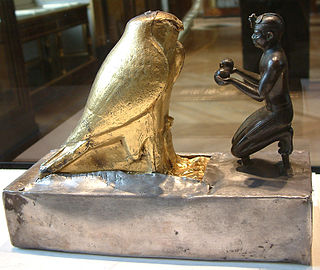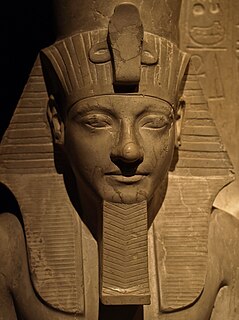
In Egyptian mythology, Hemen was a falcon–god.

Horemheb, also spelled Horemhab or Haremhab was the last pharaoh of the 18th Dynasty of Egypt. He ruled for at least 14 years between 1319 BC and 1292 BC. He had no relation to the preceding royal family other than by marriage to Mutnedjmet, who is thought to have been the daughter of his predecessor Ay; he is believed to have been of common birth.

Ay was the penultimate pharaoh of ancient Egypt's 18th Dynasty. He held the throne of Egypt for a brief four-year period in the late 1300s BC. Prior to his rule, he was a close advisor to two, and perhaps three, other pharaohs of the dynasty. It is theorized that he was the power behind the throne during Tutankhamun's reign. His prenomenKheperkheperure means "Everlasting are the Manifestations of Ra," while his nomenAy it-netjer reads as "Ay, Father of the God." Records and monuments that can be clearly attributed to Ay are rare, both because his reign was short and because his successor, Horemheb, instigated a campaign of damnatio memoriae against him and the other pharaohs associated with the unpopular Amarna Period.

Aspelta was a ruler of the kingdom of Kush. More is known about him and his reign than most of the rulers of Kush. He left several stelae carved with accounts of his reign.
Cats were represented in social and religious practices of ancient Egypt for more than 3,000 years. Several ancient Egyptian deities were depicted and sculptured with cat-like heads such as Mafdet, Bastet and Sekhmet, representing justice, fertility and power. The deity Mut was also depicted as a cat and in the company of a cat.
Georges Émile Jules Daressy was a French Egyptologist.

Satiah was an ancient Egyptian queen, the Great Royal Wife of Thutmose III.

Gebelein was a town in Egypt. It is located on the Nile, about 40 km south of Thebes, in the New Valley Governorate.

Pahemnetjer(p3-ḥm-nṯr; "servant of the god", "priest") was a High Priest of Ptah during the reign of Ramesses II. Pahemnetjer succeeded Huy as High Priest of Ptah and was in turn succeeded by his son Didia.

Wentawat, was Viceroy of Kush under Ramesses IX, during the 20th Dynasty. He was a son of the Viceroy Nahihor.
Pennesuttawy was a Military Commander and Superintendent of the Southern Lands (Kush) during the beginning of the Nineteenth Dynasty of Egypt.
The Theban Tomb TT282 is located in Dra' Abu el-Naga', part of the Theban Necropolis, on the west bank of the Nile, opposite to Luxor. It is the burial place of the ancient Egyptian Nakhtmin, also called Nakht, who lived during the reign of Ramesses II of the 19th Dynasty.

Ikhernofret was an ancient Egyptian treasurer of the 12th Dynasty, under king Senusret III until the early years of Amenemhat III. On his monuments he bears several important titles, including overseer of the double treasury, overseer of the double gold house, royal sealer and his main title treasurer. Ihkernofret is known from several stelae found at Abydos. One of these stelae contains a biography. This stela is now in the Egyptian Museum of Berlin. According to its text, Ikhernofret grew up at the royal court. When he was 26, he became friend of the king, which was most likely a special honor. However, the text of the stela is of special importance as it reports the arrangement by Ikhernofret of a festival for Osiris at Abydos.

The Tomb of Akhethetep, also known as Mastaba of Akhethetep, is a tomb complex in Saqqarah, Egypt. It was built for Akhethetep, a royal official, near the western part of the Pyramid of Djoser. Akhethetep was an official with several, mainly religious titles. including priest of Heka, priest of Khnum and priest of Horus. The tomb's decorated chapel was removed in 1903 and reassembled at the Louvre in Paris, where its is also known as the "Mastaba of Akhethetep" or simply "le mastaba du Louvre".
Senusret IV Seneferibre was an ancient Egyptian Theban king during the late Second Intermediate Period that is attested only through finds from Upper Egypt. The chronological position of Senusret IV is unclear and even the dynasty to which he belongs is debated.

Wenennefer was an ancient Egyptian High Priest of Osiris at Abydos, during the reign of pharaoh Ramesses II of the 19th Dynasty.
Nakhtmin was a Troop Commander of Kush and Royal Envoy to Every Foreign Land during the reign of Ramesses II.
Nakhtmin was an Ancient Egyptian scribe and general during the reign of pharaoh Tutankhamun.
Hori was an ancient Egyptian High Priest of Osiris at Abydos, during the reign of pharaohs Ramesses II.
Qar was an official of the Sixth Dynasty of Egypt. Son of Idu, he probably lived and served between Merenre I and Pepy II.










